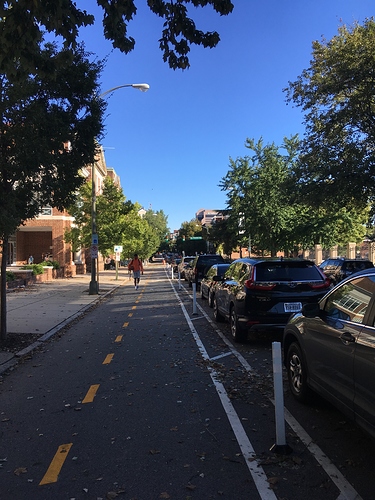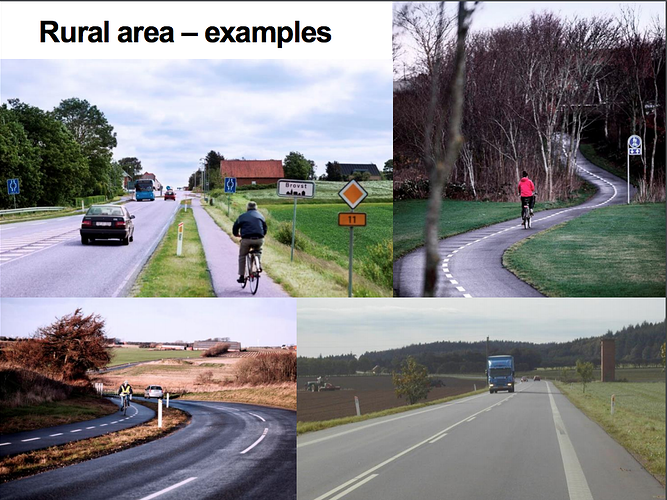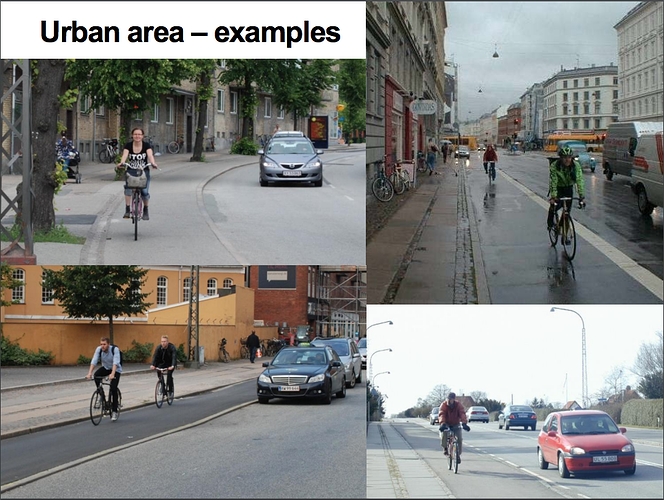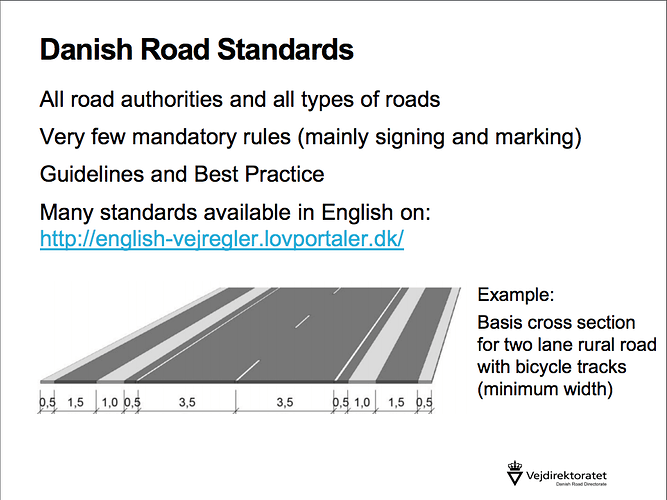Photo from this weekend of the protected cycle track in Richmond. So much opportunity for this type of infracstucture in Raleigh.
Nice, but where’s the bikes? All we see is a walker.
Interesting point. If it is not being used, is it worth it?
Thanks for asking! Oaks and Spokes has an email campaign ready to go on this (have just been waiting for clarification on when it will go to council). It now looks like November (possibly) but there is still not a clear timeline. I will post on here methods for folks to engage once we know date for review. Any time folks are not able to attend council meetings in person - emailing your rep and the at-large reps / mayor is a great way to show support. Emails can be found here: https://www.raleighnc.gov/safety/content/BoardsCommissions/Articles/CityCouncil.html
Of possible interest to this group (and Blount / Person St came up during the convo last night). Oaks and Spokes has started livestreaming Bicycle and Pedestrian Commission meetings. Catch last night’s meeting here: BPAC - October 2018
There are two bikes parked in the picture, I’m going to go out on a limb and guess they may have used the cycle track. Meanwhile I don’t see any cars doing anything other than being stationary and taking up space.
Interesting stats:
Raleigh Population Density: 2,963 / sq. mile (2018)
Richmond Population Density: 3,789 / sq. mile (2018)
NOTE: The “City of Richmond” is pretty small when compared to the neighboring counties (Henrico and Chesterfield). The City is pretty dense, but all the suburban sprawl is in the counties. Whereas the City of Raleigh is very sprawled out but still part of the city proper. VA does a weird thing where the Cities are separate from the counties. I lived in Henrico County but had a Richmond address… I couldn’t vote for Mayor or City Council because I didn’t live within the actual City. Just something to keep in mind. 
Ah true, Richmond is less than half the area of Raleigh. So perhaps Raleigh would be more dense than Rmond if we only looked at 62.5 sq. miles surrounding DT.
The city of Odense only has a population density of 1,500/sq mi but most streets have protected bike lanes. It’s about providing a quality of life for your citizens.
I hope this city only recognizes that cycletracks are just the first proof of concept and not the final format. Best used in more rural areas where vehicle speeds may make parallel bike lanes unsafe. The Danish government has spent millions of dollars perfecting city streets with bike lanes and even has an English literature to help other countries design their protected bike lanes.
Free expert advice by people that have been building protected bike lanes for decades.
I think NC is the weird place with overlapping municipal and county boundaries creating redundant services in some regards. IMO you could just get rid of State and County lines and just have local districts mashed into a country but we are so accustomed to the current system of 4 layers, nobody will be able to fathom any other way to go about it. People identifying with lines on map is really pretty silly. By I wholly digress…I love curb separated bike lanes! (back on topic)
Very true. Raleigh proper is much more inclusive of surrounding suburban development, and it even includes the giant Umstead State Park, and lots of other “unoccupied” land.
Also, following the Census estimates that put Raleigh near 465K last year, the city crossed the 3000 threshold several years ago.
On the topic, does anyone know where the year by year land area numbers for the city reside? I know that annexations are moving at a snail’s pace compared to past decades, following a state law that prevents cities from more or less annexing at will.
Yes. It appears the 3000 number was crossed sometime between 1840 and 1850.
Also someone please edit the Wikipedia page to fix that picture of Stones Warehouse representing the 'Warehouse District just west of Downtown".
Yes. The cars in the closest lane are actually parked. That switches to a moving lane during busy times but the street is plenty wide to handle everyone.
Mary, thanks for your participation here and leadership on BPAC. I believe the time has come for us to end the Incrementalism in Raleigh when it comes to our biking network. We have gotten a start using that approach for the last 10 years but now we need to create Connections. Connect the Triangle should be our new strategy. BPAC members seem to mention this at some point during every meeting but never decide to act.
I know it means committed biking infrastructure funding. It also means committing to dedicated bike lanes and agreeing that Sharrows are just paint on the road and really make no one safer.
The new Dockless Bikes and Scooters as well as the soon to be implemented Docked Bike Share programs demand us to take more aggressive action to create a real bike network. What would have to happen for Raleigh to build a network of protected bike lanes at least inside the belt line within 2 years?
Yes - would love to see that! A few clarifications:
BPAC Commissioners are not elected officials. We’re just a bunch of folks that live in Raleigh that would love to see premier facilities as the norm and advocate for their existence. Our role is to advise council and staff on what we think a project / network should look like. Staff will come to us with a proposed infrastructure project and we will provide feedback on what is missing, etc. Any recommendation we make will then go to council and they have the ability to accept it or to squash it completely.
The types of facilities everyone is talking about here that they’d love to see (separated / protected / premier) require reallocating space from cars toward people and to date there has been a limited desire with leadership to take away 1) car travel lanes or 2) parking. BPAC can advise that these installations are necessary but if there is not political bandwidth to actually implement them, we’re just talking into a vacuum.
SO - what is needed is folks like y’all stepping up and voicing your concerns (often) and letting the council know you have discontent with the way our current transportation infrastructure looks. Forums to do that include emailing your council rep, becoming involved with advocacy orgs like Oaks and Spokes and coming to a BPAC meeting to share your thoughts during the public comment section (3rd Monday at 6pm are the meetings).
If anyone wants to connect on these issues, please email me at maryesell@gmail.com and I’m happy to discuss further!
John & RobertB - I’m not familiar with the cycle track in Richmond but I think it’s good to point out that the initial aspects of a single route do not dictate the final success of a connected system.
Here in Raleigh, we’ve been pretty good at putting in bike lanes when a road needs to be resurfaced but as a result we have a bike network that is severely disconnected. If there’s a bike lane (whether it’s protected or just paint) in front of your house but then it ends a mile away and doesn’t connect to any parks/stores/jobs/schools etc… are you really going to ride it? It’s like the concept of building a highway between two cities but then stopping halfway because you don’t have enough funding.
Raleigh is not in Bicycling magazine’s 2018 top 50 bike cities. Sad.
Memphis, Chattanooga, St. Petersburg, Des Moines, Omaha, and Tallahassee are all on the list.
I’m not even joking here, but literally city I’ve been to in the last 5 years has better bike infrastructure than Raleigh (just got back from a tour including Sale Lake City, Moab and Albuquerque and they all appear much more proactive than Raleigh). Imagine how bad it’d be if not for the dedicated advocates we have (you guys rock btw…it’s just an uphill fight around here). We only got bike lanes on Hillsborough St via the lane diet because apparently the roundabouts move more traffic (and pedestrian safety was a driver as well) so anything is cool as long as you can more cars through. Mustn’t impede traffic. Everywhere else is just striping where there happened to be room. Cheap. Allows the City to claim it’s doing something while it’s really doing very little. Greeways? bleh. Recreational is about all they do for us. I understand many roads in Raleigh are NCDOT roads therefore the City is handcuffed. The NCDOT bike Division is woefully underfunded and generally ignored anyway. This is not a progressive city on most fronts and definitely not when it comes to government supported biking initiatives. It is a tepid, and unsure follower, and in full deference to the unbridled development crowd that wants low taxes, low standards and can’t see past today’s account balance even if smart investment now lowers costs later (like, give us another way to work so you’re not considering elevated freeways through downtown in 20 years).
When I tell people I bike to work, I have never met a single person who says “I hate cycling, I am glad I get to drive instead.” The responses frequently that the person I am talking to says they love biking too but only on the greenways because they don’t feel safe anywhere else.
Hypothetically speaking, if we took a lane from every single multi lane road in town and turned it into a protected cycle track, a lot of these people would likely switch to bike travel for shorter distances (say, 3-5 miles or less.) This would be cheap to implement too.
It is the insistence that bike infra can only be built if vehicular capacity is maintained or increased at the same time that makes it unaffordable.
I recognize that this would be disruptive and that the status quo would die hard. But it is important to acknowledge that it is only a matter of priorities and policy that keeps us from having adequate cycle infrastructure, not money.



